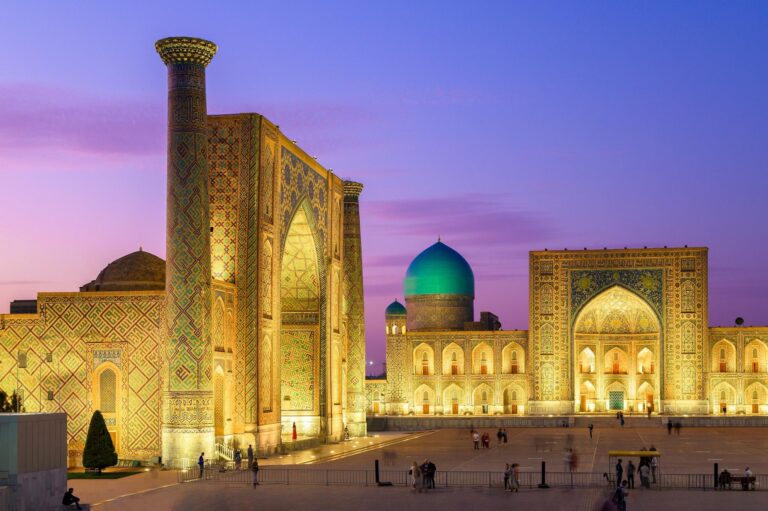Several countries in Central Asia (sometimes collectively referred to as Stans) are rolling out ambitious tourism industry development programs in hopes of giving the region a foothold on the global travel map.
However, the future of the hospitality industry remains uncertain in most parts of the region due to a complex mix of political, infrastructure and environmental challenges.
Kazakhstan, Central Asia’s largest economy, has seen major changes in the country’s hospitality industry over the past two years, said Alexei Vishnevsky, front office manager at Dostyk Hotel in the country’s capital Astana.
Vishnevsky said that in addition to seeing a steady increase in occupancy rates and average room rates, hotel bookings are now available 50 or even 60 days in advance by 2023, up from only seven days or so a few years ago.
Several factors contributed to this positive trend.
“In general, the post-pandemic period has seen an increased interest in travel among people who have spent two years confined to their homes,” Vishnevsky said.
He added that the Silk Road, which passes through many of Stans’ capitals and major cities, remains an iconic and epic journey for many of its adventurous guests.
Vishnevsky said hotel occupancy in the region has increased due to the war between Russia and Ukraine. Kazakh government officials say Russia’s mobilization has forced about 400,000 Russians to flee to Kazakhstan.
Talgat Amanbayev, chairman of the Kazakhstan Government Agency, said Kazakhstan plans to attract 1 million tourists per year from 2022 to 2025.
According to hospitality data from CoStar, average occupancy rates for branded hotels in Kazakhstan were 60.1% for the first nine months of 2023, up from 52.5% for the same period in 2022. Average daily rates jumped to 94.50 euros ($102.22) during the period, while revenue per available room increased to 56.76 euros.
It is too early to tell whether Kazakh hoteliers are preparing for a bright future, but the positive trend in demand should continue.
“Among the factors affecting the hospitality industry, the general economic instability should be mentioned right away,” said Askar, general manager of the Altin Eco Park hotel, also in Astana.・Mr. Rubilov said.
In January 2022, Kazakhstan was hit by widespread riots sparked by anger over a huge increase in gasoline prices, Rubilov said. During days of rioting, government buildings were burned, businesses and banks were looted, airports were occupied, and even arms depots were ransacked.
Political unrest remains common in Central Asia, making it difficult for the global hotel industry to penetrate that half of the region.
Neighboring Kyrgyzstan could potentially be a very attractive market for hoteliers, said Marina Smirnova, head of the hospitality and tourism sector at Moscow-based consultancy Commonwealth Partnership. , pointed out that frequent changes in management are a bottleneck.
Smirnova added that Turkmenistan is a promising tourist destination but remains largely closed to the outside world.
“In most Central Asian countries, large numbers of foreign players are unlikely to line up for financial injections until local authorities establish ‘transparent and permanent rules of the game,'” Smirnova said.
She added that for the hotel industry to begin to unlock the region’s potential, restrictions on foreigners purchasing land and real estate need to be lifted.
The number of overnight guests in Kazakhstan remains steady, mainly in Almaty and Astana. In recent years, authorities have been actively promoting the Caspian coast to foreign tourists, but without much success, Smirnova said.
“The Caspian Sea has many disadvantages, including a muddy bottom, a unique water color, and frequent outbreaks of E. coli infections,” she added.
Tourism growth opportunities look more optimistic in Uzbekistan, the second-largest economy in Central Asia and the country’s most popular tourist destination, according to Svetlana Barakina, general manager of the Dilimah Premium Luxury Hotel in Samarkand.
Barakina said the hotel’s occupancy rate is expected to be 62% in 2023, slightly above pre-pandemic levels, and ADR has increased 10-15% year-over-year.
Under its tourism development plan, Uzbekistan is targeting 9 million foreign tourists by 2023, up from 5.2 million in 2022. The government has announced it will invest in transport infrastructure, which remains the Achilles heel of the regional tourism sector.
“The cost is [air] For tourists from Europe and America, airfare to Uzbekistan is very expensive,” Barakina said.
A new airport in Samarkand, Uzbekistan, has opened with direct flights to several new destinations starting in 2023. The initiative sparked what local market players say is a hotel construction boom.
“Many hotels of different categories have opened, not just chain hotels,” Barakina said.
She said that in addition to the traditional feeder markets of neighbouring Stan countries, hoteliers were pleased to see an increase in visitors from Arab countries.
Unlike Kazakhstan, Uzbekistan has historically been a popular tourist destination during the Soviet era, and Silk Road cities were well known to foreign tourists, Smirnova said.
For the first nine months of 2023, hotel occupancy in Uzbekistan fell to 53.7%, but ADR increased to EUR 123.14 and RevPAR increased to EUR 66.18 for the period.
“Due to strong seasonal factors, hotel occupancy is lower than in Kazakhstan. In addition, the number of hotels in Tashkent has expanded recently, hotels of international standards are being built in Samarkand, and projects are being built in Khiva. inside,” Smirnova said. He said.
Barakina said the influx of new investors into Uzbekistan’s hotel industry is so strong that there is even a risk of oversupply in the market.
“Businesses are rushing to take advantage of the expected increase in international tourist numbers and, in some cases, [investors] We must not forget about appropriate investments to maintain a high level of service,” she added.
Read more news on Hotel News Now.

